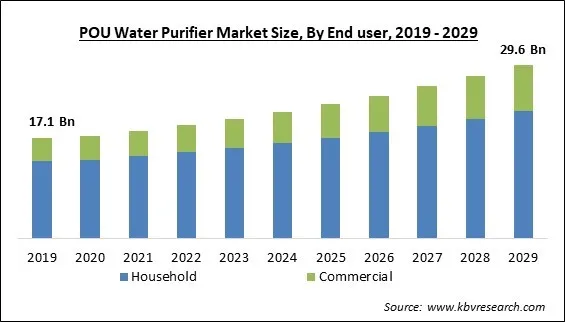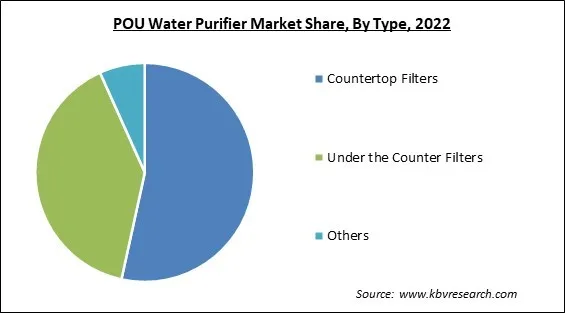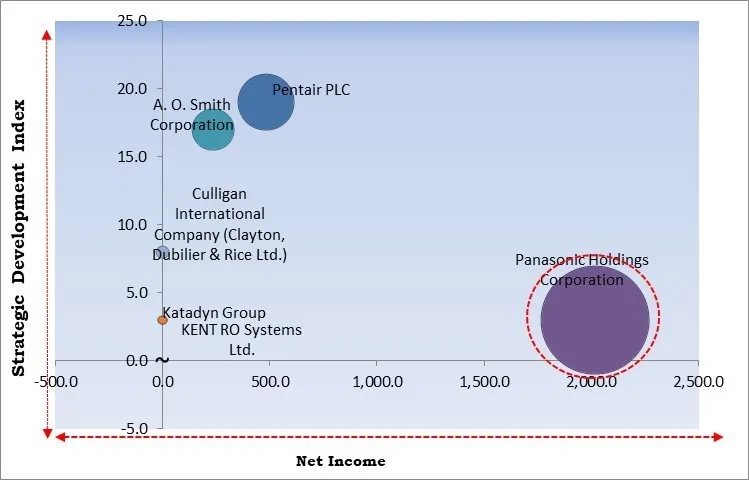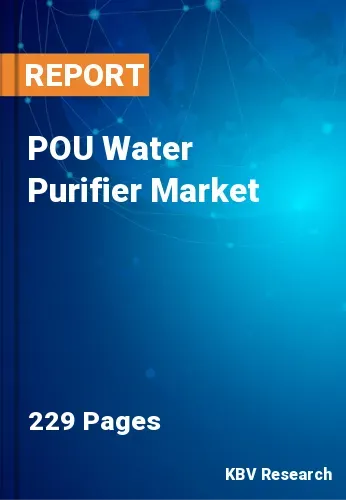The Global POU Water Purifier Market size is expected to reach $29.6 billion by 2029, rising at a market growth of 6.4% CAGR during the forecast period.
A water purification device called a POU (point-of-use) water purifier is made to clean water right where it is consumed. Numerous technologies, including UV, RO, and UV+RO, remove or minimize impurities while maintaining water quality. POU water purifiers are commonly installed at a single water connection on the countertop of a residential or business building and beneath the counter of a bathroom or kitchen sink.

Drinking water from untreated sources, such as rivers, lakes, and wells, is purified using portable, self-contained water purifiers. Water purifiers disinfect the water by eliminating dangerous germs and the tiny Cryptosporidium parasites that can cause diarrhea. The majority of places where water purifiers are utilized are homes and businesses. Additionally, they are utilized by campers, military personnel, hikers, and employees who live in places with a shortage of drinking water as well as by those in disaster-prone areas. These water purifiers are also sometimes referred to as point of use water treating Systems.
Protozoa, parasitic worms, bacteria, algae, viruses, and other bacteria and pathogen infections lead to the development of waterborne disorders. When polluted water is consumed, it can result in illnesses including cholera, campylobacteriosis, lead poisoning, malaria, and others like diarrhea and typhoid. These illnesses are brought on by consuming raw, contaminated drinking or surface water when showering, washing dishes, or eating food.
Consumers are growing more worried about their health and leaning toward filtered water to reduce the danger of waterborne diseases as awareness of and access to information about waterborne diseases grows. The government and industry are also running water campaigns to raise awareness of water filtration and surface water treatment. As a result, consumers are gravitating toward POU water purifiers because of increased awareness of the importance of safe and clean drinking water, which is anticipated to fuel market expansion for these devices.
The rise in demand for point-of-use water purifier systems in the residential sector is a result of the culture of working from home. The point-of-use water purifier market is experiencing growth due to growing demand from customers for high-quality drinking water, rising health concerns, and the convenience of purchasing these devices through retail channels. As a result of strict government regulations put in place by various nations, businesses are concentrating on producing environmentally friendly point-of-use water purifying systems, fueling their popularity and fostering market expansion for POU water purifier both during and after the pandemic.
Contaminated drinking water poses a significant health risk as it can transmit various diseases, including but not limited to diarrhea, cholera, dysentery, typhoid, and polio. It is estimated that such contamination causes approximately 485,000 diarrheal deaths annually. Access to safe and adequate water is crucial for promoting hygiene practices, which are essential in preventing diarrheal illnesses, acute respiratory infections, and various neglected tropical diseases. Thus, the high amount of people suffering or prone to waterborne diseases will increase the requirement for water treating systems like POU water purifiers, propelling market growth.
The presence of heavy metals in the water supply system has been on the rise over the past few decades, primarily due to the increase in industrial activities. The toxic effects of heavy metals on health make their presence in the environment a significant concern. A variety of metals, including lead (Pb), Cd, Zn, manganese (Mn), copper (Cu), mercury (Hg), nickel (Ni), and chromium (Cr), can be found in both agricultural and industrial wastewater. It is important to reduce the amount of heavy metal content in wastewater prior to discharge, which is expected to raise the demand for POU water purifiers to treat the contaminated water and therefore aid in the market growth.
The cost of reverse osmosis filters and ultra-violet filters is high. A workforce with technical skills is necessary to achieve optimal design and comply with standard regulations. This results in an increase in production costs for filters. The operational expenses of point-of-use water purifier systems are contingent on the necessary filters and technology. RO water purification systems typically entail greater maintenance expenses than alternative systems. To ensure water output quality, replacing the purifier filters every three to six months is necessary. The system's elevated maintenance and operational expenses result from this.
Based on type, the POU water purifier market is segmented into countertop filters, under the counter filters and others. The under the counter filters segment acquired a significant revenue share in the POU water purifier market in 2022. This is because under the counter water dispensing systems have a higher flow rate, allowing for efficient and quick bottle filling. Typically, these systems are installed beneath the kitchen counter. Additionally, these filters are space-efficient and easy to install without the need for extensive modifications.

On the basis of technology, the POU water purifier market is divided into UV, RO, UV & RO and others. The RO segment held the highest revenue share in the POU water purifier market in 2022. This is because RO technology is a commonly utilized method in water purifiers for eliminating impurities from unfiltered water. The influx of new players in the water purifier industry can be attributed to the growing consumer awareness of waterborne diseases. In addition, the RO water purifiers segment is experiencing growth due to innovative marketing techniques employed by various companies and increased popularity among high-end customers.
By end-user, the POU water purifier market is classified into household and commercial. The commercial segment garnered a prominent revenue share in the POU water purifier market in 2022. The growth is attributed to the significant growth of the business sector due to the increasing demand for commercial spaces and the establishment of new offices. Furthermore, large-scale water purification systems installed in light commercial buildings offer similar benefits to compact filtration units used in residential settings. The mentioned factors and the constant growth of the water purifier is expected to propel the segment's growth.
Based on the distribution channel, the POU water purifier market is bifurcated into B2B and B2C. The B2C segment registered the highest revenue share in the POU water purifier market in 2022. This is because the majority of water purifiers are purchased in brick-and-mortar stores, and brand loyalty is more easily established in rural regions of emerging economies. The offline market plays a critical role for consumers residing in those areas. By adopting a B2C eCommerce model, POU water purifier providers can reduce expenses related to infrastructure, electricity, staffing, and other associated costs.
| Report Attribute | Details |
|---|---|
| Market size value in 2022 | USD 19.3 Billion |
| Market size forecast in 2029 | USD 29.6 Billion |
| Base Year | 2022 |
| Historical Period | 2019 to 2021 |
| Forecast Period | 2023 to 2029 |
| Revenue Growth Rate | CAGR of 6.4% from 2023 to 2029 |
| Number of Pages | 229 |
| Number of Table | 432 |
| Report coverage | Market Trends, Revenue Estimation and Forecast, Segmentation Analysis, Regional and Country Breakdown, Competitive Landscape, Companies Strategic Developments, Company Profiling |
| Segments covered | Technology, Type, Distribution Channel, End user, Region |
| Country scope | US, Canada, Mexico, Germany, UK, France, Russia, Spain, Italy, China, Japan, India, South Korea, Singapore, Malaysia, Brazil, Argentina, UAE, Saudi Arabia, South Africa, Nigeria |
| Growth Drivers |
|
| Restraints |
|
Region-wise, the POU water purifier market is analyzed across North America, Europe, Asia Pacific, and LAMEA. The Asia Pacific region generated the highest revenue share in the POU water purifier market in 2022. The Asia-Pacific region represents the primary market for point-of-use water purifiers. Brand penetration is more robust in developed countries of the region. In the Asia-Pacific region, there is a growing demand for domestic water purifier units, particularly in metropolitan areas and large cities. This is due to the increasing levels of microbiological and chemical contamination in surface water supplies.
Free Valuable Insights: Global POU Water Purifier Market size to reach USD 29.6 Billion by 2029

The major strategies followed by the market participants are Acquisitions. Based on the Analysis presented in the Cardinal matrix; Panasonic Holdings Corporation are the forerunners in the POU Water Purifier Market. Companies such as A. O. Smith Corporation, Culligan International Company and Pentair PLC are some of the key innovators in POU Water Purifier Market.
The market research report covers the analysis of key stakeholders of the market. Key companies profiled in the report include Panasonic Holdings Corporation, A. O. Smith Corporation, Pentair PLC, The Katadyn Group, Culligan International Company (Clayton, Dubilier & Rice Ltd.), KENT RO Systems Ltd., Ace Hygiene Products Pvt. Ltd., Brondell, Inc., Crystaline Water Master Co., Ltd. And Amway Corporation.
By Technology
By Type
By Distribution Channel
By End user
By Geography


The Market size is projected to reach USD 29.6 billion by 2029.
Increase in industrial operations raising demand for water purification systems are driving the Market in coming years, however, The high cost of production and maintenance restraints the growth of the Market.
Panasonic Holdings Corporation, A. O. Smith Corporation, Pentair PLC, The Katadyn Group, Culligan International Company (Clayton, Dubilier & Rice Ltd.), KENT RO Systems Ltd., Ace Hygiene Products Pvt. Ltd., Brondell, Inc., Crystaline Water Master Co., Ltd. And Amway Corporation.
The Countertop Filters segment acquired maximum revenue share in the Global POU Water Purifier Market by Type in 2022 thereby, achieving a market value of $15.4 billion by 2029.
The Household segment is leading the Market by End user in 2022, thereby, achieving a market value of $21.7 billion by 2029.
The Asia Pacific market dominated the Market by Region in 2022, and would continue to be a dominant market till 2029; thereby, achieving a market value of $11.8 billion by 2029.
Our team of dedicated experts can provide you with attractive expansion opportunities for your business.

